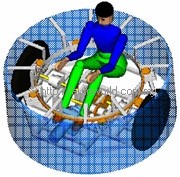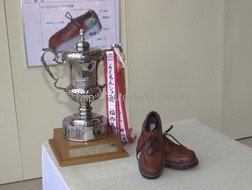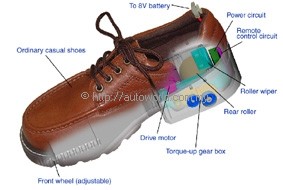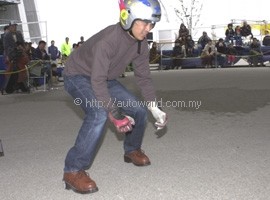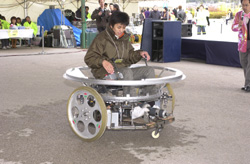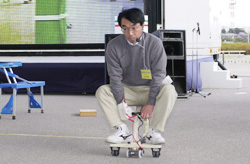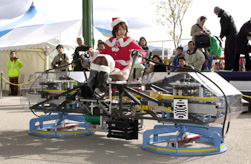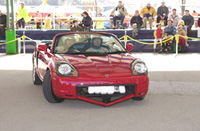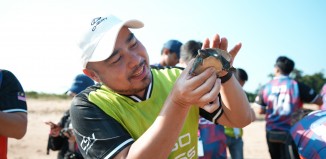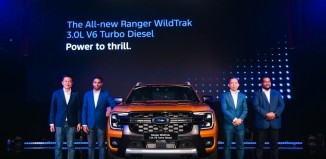Toyota Idea Expo 2002
Each year, for the past 26 years, a unique event has been organised by the Toyota Engineering Society (TES) which was formed in 1947. To the rest of the world, it seems like a wacky event with weird contraptions being paraded around but the event is really a way for engineers to think well beyond their usual limits by ‘removing the wet blankets of costs and practicality’.
Known as the Toyota Idea Expo (sometimes also called the ‘Idea Olympics’), the event allows Toyota engineers to give their creative DNA free rein. This year, the theme was “Technology Big Bang – Invention and Connection – Waking Up Creative DNA” and there were 362 entries.
For this year’s event, TES members were encouraged to participate with original inventions and vehicles in three categories: the Vehicle Invention Contest, the Jumping Mechanism Contest, and a “Formula Wind” Mini-Car race.
The Chairman’s Award went to the ultra-small self-propelled “Easy Shoes,” (size 26), which can carry one 70-kg “driver.” Its rear-wheel drive format uses two electric motors, one in the heel of each shoe. The motors are of the high-torque type employed in automatic electric air rifles. To prevent buckling of the leather sole and assure sufficient rigidity to support the driver on the hard urethane rear roller and front roller, there’s a machined aluminium base. This also enhances passive safety, a significant addition in a vehicle where the only “safety belt” is holding up the driver’s trousers.
The inventor of the “Easy Shoes” – which can be regarded as the smallest motor vehicle in the world – was 32-year old Atsushi Fukunishi. His regular job is to design electronic fuel injection systems for Toyota vehicles but for the past 6 months, he spent his free time working on his ‘secret project’. He had entered the idea contest four times previously and his best effort was fifth place.
Fukunishi said the most difficult job was fitting the motor, gears, remote control circuit and power circuit into the heel of the shoe. The batteries are attached inside the driver’s trouser legs. High-torque motors are embedded in heels – a feat of miniaturization. Several steps ahead of their time, “Easy Shoes” incorporate all drive and control components within standard street footwear.
Winning the Gold Award was a “One-Way Safety Cart” created by a 6-person team. Powered by a single electric motor, the circular-bodied vehicle can reverse its direction of travel without backing up or making a U-turn, thanks to an ingenious gear and clutch arrangement. The wheels and body stay in place, while the interior section, including the driver’s seat, rotates. Once rotation is completed, the vehicle can drive off in the opposite direction. Just the thing for drivers who are not good at backing up!
The “Stick Walker” was the Silver Award winner and is an ultra-compact collapsible electric scooter developed by a 6-person team. A flexible drive shaft connects the front drive wheel to a motor and battery pack carried in a waist pouch worn by the user. The tiny rear platform folds up for portability, and is linked to the front steering arm by two hinges and a pivot, which permit the user to balance and turn with ease. It can also be used as a kick scooter.
The Bronze Award winner was the “Wearable Car” developed by Nobuyuki Ando and demonstrated with the help of his young son. This vehicle can be wrapped around the waist when not in use; to turn it into a motor vehicle, the user removes the belt and reverses its curvature, linking the wheeled ends with a cable. The result is a highly-rigid electric scooter with a seat and footrests. Needless to say, this wearable car requires no parking space and can be stored in a bag or locker at one’s destination.
An additional Chairperson Award from TES Chairman Dr Akihiko Saito (who was the Chief Engineer of the Corolla in the 1980s) went to the “Compass Boy.” Based on the format of a drafting compass, this vehicle moves forward on two pods, between which the driver sits. The rim of either pod can be lowered to the pavement to serve as a pivot while the opposite pod arcs forward or backward on casters.
After the awards ceremony, members of the audience were invited to try out the amazing vehicles. A big crowd-pleaser was a Toyota MR-S sportscar customized to exhibit facial expressions. Features of the “Boro Cop”, as it was called, included a bumper “jaw” that dropped to reveal a toothy smile, and headlamp “eyes” that popped out in surprise!
In the environmental arena, a fuel-cell driven “Ultra-FC bicycle” was exhibited that creates its own hydrogen fuel by electrolysis, using solar cells mounted on the handlebars. In turn, the rear-mounted fuel cells drive an electric motor attached to the front wheel. The pedals can be used to turn the rear wheel as usual.
Also exhibited in the Idea Contest were a caterpillar-tread scooter called the “Earth Explorer,” featuring removable modules for different terrains; a “Two-wheel Unicycle,” using vertical and horizontal flywheels to maintain balance; and the “USO” (Unidentified Sliding Object) which mysteriously translates the movement of the driver about a central “steering wheel” into forward motion of the vehicle – small wheels turn in reaction to pressure from the frame, without the intervention of gears.
The Jumping Mechanism Contest produced its own remarkable array of whimsical inventions, 28 of which were on display, out of a total of 170 entries. The Gold Award winner was the “Genius Jump-roper,” which claimed to have broken the world’s rope jumping record by staying aloft for 7 consecutive spins of the rope. Using the force of repulsion of permanent magnets, “Genius Jump-roper” skips in synch with rope movement
In the “Formula Wind” race, wooden decks were outfitted with tiny electric fan/propellers creating something like an airboat of the type used in the Everglades and similar swampy areas, but with wheels. These fan-driven vehicles competed on a complex racecourse that included a stretch of water. Regional elimination rounds narrowed down the starting field of 309 to 34 finalists who competed on the day of Idea Expo.
To let the younger attendees experience the fun and fascination of making things, “Handing Down Technology” workshops were held in parallel with the other events. Children constructed electric-motor hovercraft, metal badges, key-holders, surface gliders (winged water craft that skim the surface of the water) and paper vehicles.
To its participants, Toyota’s Idea Expo is an opportunity to rejuvenate the creative spirit that brought them to the discipline of engineering in the first place. To the visitor, it is a reminder that the vehicles that do go into production are the result of a company-wide creative effort.
Toyota President Fujio Cho believes such creativity is especially important at this point in the history of motorization. The automotive industry will see “evolution with great diversity” in the first half of the 21st century, according to Mr Cho. The wild seeds of that diversity were most evident and in abundance at this year’s Idea Expo which was held in Toyota City.




